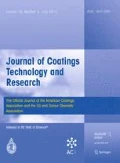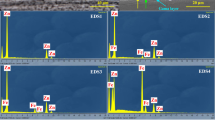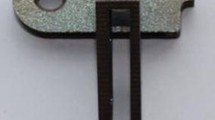Abstract
This article describes the study of the topography effect of superhydrophobic surfaces on the corrosion protection performance of steel through the air plastron behavior when subjected to an underwater environment. A random superhydrophobic surface was fabricated using spray coating and characterized for morphology and wettability by scanning electron microscopy (SEM) and goniometer measurements, respectively. By comparing the coated surfaces both with and without air plastron, it was found that superhydrophobicity postponed the corrosion of the coated steel specimens. This increase in corrosion protection of the superhydrophobic surface was due to the air plastron created by the superhydrophobicity in underwater immersion. Since different areas showed differing air plastron lifetimes (wetting behavior), it was assumed that the underlying topography of the superhydrophobic coating controlled the air plastron lifetime. To investigate this behavior, the micron scale topography of the different areas was studied using the technique of laser confocal microscopy over the specific areas and correlating with air plastron lifetime. Using the theoretical analysis based on superhydrophobic robustness and assuming the solid fraction is the same for different locations, it was demonstrated that the feature size [extracted by roughness analysis as root-mean-square (RMS)] correlated with the air plastron lifetime. It was confirmed from the plot of RMS and air plastron lifetime that smaller feature sizes could extend the air plastron lifetime and provide better anticorrosion performance.





Similar content being viewed by others
References
Renner, FU, Stierle, A, Dosch, H, Kolb, DM, Lee, T-L, Zegenhagen, J, “Initial Corrosion Observed on the Atomic Scale.” Nature, 439 707 (2006)
Dwivedi, D, Lepková, K, Becker, T, “Carbon Steel Corrosion: A Review of Key Surface Properties and Characterization Methods.” RSC Adv., 7 4580–4610 (2017)
Revie, RW, Corrosion and Corrosion Control: An Introduction to Corrosion Science and Engineering, pp. 1–4. Wiley, New York (2008)
Schweitzer, PA, Corrosion and Corrosion Protection Handbook, pp. 13–14. CRC Press, Boca Raton (1989)
Ogawa, T, Koseki, T, “Effect of Composition Profiles on Metallurgy and Corrosion Behavior of Duplex Stainless-Steel Weld Metals.” Weld. J., 68 181 (1989)
Marshall, PI, Gooch, TG, “Effect of Composition on Corrosion Resistance of High-Alloy Austenitic Stainless-Steel Weld Metals.” Corrosion, 49 514–526 (1993)
Krishnamurthy, S, Khobaib, M, Robertson, E, Froes, FH, “Corrosion Behavior of Rapidly Solidified Mg Nd and Mg Y Alloys.” Mater. Sci. Eng., 99 507–511 (1988)
Ha, HM, Miller, JR, Payer, JH, “Devitrification of Fe-Based Amorphous Metal SAM 1651 and the Effect of Heat-Treatment on Corrosion Behavior.” J. Electrochem. Soc., 156 C246–C252 (2009)
Raja, PB, Sethuraman, MG, “Natural Products as Corrosion Inhibitor for Metals in Corrosive Media—A Review.” Mater. Lett., 62 113–116 (2008)
Pistofidis, N, Vourlias, G, Konidaris, S, Pavlidou, E, Stergiou, A, Stergioudis, G, “Microstructure of Zinc Hot-Dip Galvanized Coatings Used for Corrosion Protection.” Mater. Lett., 60 786–789 (2006)
Hosking, NC, Ström, MA, Shipway, PH, Rudd, CD, “Corrosion Resistance of Zinc–Magnesium Coated Steel.” Corros. Sci., 49 3669–3695 (2007)
Grundmeier, G, Schmidt, W, Stratmann, M, “Corrosion Protection by Organic Coatings: Electrochemical Mechanism and Novel Methods of Investigation.” Electrochim. Acta., 45 2515–2533 (2000)
Wang, S, Jiang, L, “Definition of Superhydrophobic States.” Adv. Mater., 19 3423–3424 (2007)
Vazirinasab, E, Jafari, R, Momen, G, “Application of Superhydrophobic Coatings as a Corrosion Barrier: A Review.” Surf. Coat. Technol., 341 40–56 (2018)
Zhang, D, Wang, L, Qian, H, Li, X, “Superhydrophobic Surfaces for Corrosion Protection: A Review of Recent Progresses and Future Directions.” J. Coat. Technol. Res., 13 11–29 (2016)
Callies, M, Quéré, D, “On Water Repellency.” Soft Matter., 1 55–61 (2005). https://doi.org/10.1039/b501657f
Quéré, D, “Non-sticking Drops.” Reports Prog. Phys., 68 2495–2532 (2005). https://doi.org/10.1088/0034-4885/68/11/R01
Ejenstam, L, Ovaskainen, L, Rodriguez-Meizoso, I, Wågberg, L, Pan, J, Swerin, A, Claesson, PM, “The Effect of Superhydrophobic Wetting State on Corrosion Protection–The AKD Example.” J. Colloid Interface Sci., 412 56–64 (2013)
Wang, N, Xiong, D, “Superhydrophobic Membranes on Metal Substrate and Their Corrosion Protection in Different Corrosive Media.” Appl. Surf. Sci., 305 603–608 (2014)
Wang, P, Zhang, D, Qiu, R, Wu, J, “Super-Hydrophobic Metal-Complex Film Fabricated Electrochemically on Copper as a Barrier to Corrosive Medium.” Corros. Sci., 83 317–326 (2014)
Zhang, D, Qian, H, Wang, L, Li, X, “Comparison of Barrier Properties for a Superhydrophobic Epoxy Coating Under Different Simulated Corrosion Environments.” Corros. Sci., 103 230–241 (2016)
Liu, T, Yin, Y, Chen, S, Chang, X, Cheng, S, “Super-Hydrophobic Surfaces Improve Corrosion Resistance of Copper in Seawater.” Electrochim. Acta., 52 3709–3713 (2007)
Liu, T, Chen, S, Cheng, S, Tian, J, Chang, X, Yin, Y, “Corrosion Behavior of Super-Hydrophobic Surface on Copper in Seawater.” Electrochim. Acta., 52 8003–8007 (2007)
Liu, K, Zhang, M, Zhai, J, Wang, J, Jiang, L, “Bioinspired Construction of Mg-Li Alloys Surfaces with Stable Superhydrophobicity and Improved Corrosion Resistance.” Appl. Phys. Lett., 92 1–4 (2008). https://doi.org/10.1063/1.2917463
Wang, Z, Li, Q, She, Z, Chen, F, Li, L, Zhang, X, Zhang, P, “Facile and Fast Fabrication of Superhydrophobic Surface on Magnesium Alloy.” Appl. Surf. Sci., 271 182–192 (2013). https://doi.org/10.1016/j.apsusc.2013.01.158
Peng, CW, Chang, KC, Weng, CJ, Lai, MC, Hsu, CH, Hsu, SC, Li, SY, Wei, Y, Yeh, JM, “UV-Curable Nanocasting Technique to Prepare Bio-Mimetic Super-Hydrophobic Non-Fluorinated Polymeric Surfaces for Advanced Anticorrosive Coatings.” Polym. Chem., 4 926–932 (2013). https://doi.org/10.1039/c2py20613g
Rao, AV, Latthe, SS, Mahadik, SA, Kappenstein, C, “Mechanically Stable and Corrosion Resistant Superhydrophobic Sol-Gel Coatings on Copper Substrate.” Appl. Surf. Sci., 257 5772–5776 (2011). https://doi.org/10.1016/j.apsusc.2011.01.099
Qing, Y, Yang, C, Hu, C, Zheng, Y, Liu, C, “A Facile Method to Prepare Superhydrophobic Fluorinated Polysiloxane/ZnO Nanocomposite Coatings with Corrosion Resistance.” Appl. Surf. Sci., 326 48–54 (2015). https://doi.org/10.1016/j.apsusc.2014.11.100
Chen, X, Yuan, J, Huang, J, Ren, K, Liu, Y, Lu, S, Li, H, “Large-Scale Fabrication of Superhydrophobic Polyurethane/Nano-Al2O3 Coatings by Suspension Flame Spraying for Anti-Corrosion Applications.” Appl. Surf. Sci., 311 864–869 (2014). https://doi.org/10.1016/j.apsusc.2014.05.186
Khorsand, S, Raeissi, K, Ashrafizadeh, F, “Corrosion resistance and Long-Term Durability of Super-Hydrophobic Nickel Film Prepared by Electrodeposition Process.” Appl. Surf. Sci., 305 498–505 (2014). https://doi.org/10.1016/j.apsusc.2014.03.123
She, Z, Li, Q, Wang, Z, Tan, C, Zhou, J, Li, L, “Highly Anticorrosion, Self-Cleaning Superhydrophobic Ni-Co Surface Fabricated on AZ91D Magnesium Alloy.” Surf. Coat. Technol., 251 7–14 (2014). https://doi.org/10.1016/j.surfcoat.2014.03.060
Qiu, R, Zhang, D, Wang, P, “Superhydrophobic-Carbon Fibre Growth on a Zinc Surface for Corrosion Inhibition.” Corros. Sci., 66 350–359 (2013)
Balmert, A, Bohn, HF, Ditsche-Kuru, P, Barthlott, W, “Dry Under Water: Comparative Morphology and Functional Aspects of Air-Retaining Insect Surfaces.” J. Morphol., 272 442–451 (2011)
Jones, PR, Hao, X, Cruz-Chu, ER, Rykaczewski, K, Nandy, K, Schutzius, TM, Varanasi, KK, Megaridis, CM, Walther, JH, Koumoutsakos, P, “Sustaining Dry Surfaces Under Water.” Sci. Rep., 5 12311 (2015)
Golovin, K, Boban, M, Mabry, JM, Tuteja, A, “Designing Self-Healing Superhydrophobic Surfaces with Exceptional Mechanical Durability.” ACS Appl. Mater. Interfaces., 9 11212–11223 (2017). https://doi.org/10.1021/acsami.6b15491
Gose, JW, Golovin, K, Boban, M, Mabry, JM, Tuteja, A, Perlin, M, Ceccio, SL, “Characterization of Superhydrophobic Surfaces for Drag Reduction in Turbulent Flow.” J. Fluid Mech., 845 560–580 (2018)
Nahum, T, Dodiuk, H, Kenig, S, Panwar, A, Barry, C, Mead, J, “The Effect of Composition and Thermodynamics on the Surface Morphology of Durable Superhydrophobic Polymer Coatings.” Nanotechnol. Sci. Appl., 10 53–68 (2017). https://doi.org/10.2147/NSA.S123447
Poetes, R, Holtzmann, K, Franze, K, Steiner, U, “Metastable Underwater Superhydrophobicity.” Phys. Rev. Lett., 105 166104 (2010)
Lv, P, Xue, Y, Shi, Y, Lin, H, Duan, H, “Metastable States and Wetting Transition of Submerged Superhydrophobic Structures.” Phys. Rev. Lett., 112 196101 (2014)
Tuteja, A, Choi, W, Ma, M, Mabry, JM, Mazzella, SA, Rutledge, GC, McKinley, GH, Cohen, RE, “Designing Superoleophobic Surfaces.” Science (80), 318 1618–1622 (2007). https://doi.org/10.1126/science.1148326
Tuteja, A, Choi, W, Mabry, JM, McKinley, GH, Cohen, RE, “Robust Omniphobic Surfaces.” Proc. Natl. Acad. Sci., 105 18200–18205 (2008). https://doi.org/10.1073/pnas.0804872105
Kim, CJ, Liu, TL, “Turning a Surface Superrepellent Even to Completely Wetting Liquids.” Science., 346 1096–1100 (2014)
Larmour, IA, Bell, SEJ, Saunders, GC, “Remarkably Simple Fabrication of Superhydrophobic Surfaces Using Electroless Galvanic Deposition.” Angew. Chemie Int. Ed., 46 1710–1712 (2007)
Govardhan, RN, Srinivas, GS, Asthana, A, Bobji, MS, “Time Dependence of Effective Slip on Textured Hydrophobic Surfaces.” Phys. Fluids., (2009). https://doi.org/10.1063/1.3127123
Lee, C, Kim, CJ, “Underwater Restoration and Retention of Gases on Superhydrophobic Surfaces for Drag Reduction.” Phys. Rev. Lett., 106 1–4 (2011). https://doi.org/10.1103/PhysRevLett.106.014502
Lee, SG, Ham, DS, Lee, DY, Bong, H, Cho, K, “Transparent Superhydrophobic/Translucent Superamphiphobic Coatings Based on Silica–Fluoropolymer Hybrid Nanoparticles.” Langmuir, 29 15051–15057 (2013)
Campos, R, Guenthner, AJ, Meuler, AJ, Tuteja, A, Cohen, RE, McKinley, GH, Haddad, TS, Mabry, JM, “Superoleophobic Surfaces Through Control of Sprayed-on Stochastic Topography.” Langmuir, 28 9834–9841 (2012). https://doi.org/10.1021/la301480s
Rajappan, A, Golovin, K, Tobelmann, B, Pillutla, V, Abhijeet, W, Choi, A, Tuteja, GH, “McKinley, Influence of Textural Statistics on Drag Reduction by Scalable, Randomly Rough Superhydrophobic Surfaces in Turbulent FlowMcKinley, Influence of Textural Statistics on Drag Reduction by Scalable, Randomly Rough Superhydrophobic Surfaces in Turbulent Flow.” Phys. Fluids., 31 42107 (2019)
Yuan, Y, Choi, SO, Kim, J, “Analysis of Contact Area Between Water and Irregular Fibrous Surface for Prediction of Wettability.” RSC Adv., 6 73313–73322 (2016). https://doi.org/10.1039/c6ra15389e
Whitehouse, DJ, Handbook of Surface and Nanometrology, pp. 5–14. CRC Press, Boca Raton (2010)
Varanasi, KK, Deng, T, Hsu, M, Bhate, N, “Hierarchical Superhydrophobic Surfaces Resist Water Droplet Impact.” Tech. Proc. NSI Nanotechnology Conf., Houston, TX (2009)
He, Y, Jiang, C, Wang, S, Yin, H, Yuan, W, “Control Wetting State Transition by Micro-Rod Geometry.” Appl. Surf. Sci., 285 682–687 (2013)
Acknowledgments
This work was supported by a Grant (Code No. N00014-16-R-BA01) from the Office of Naval Research. We thank Olympus Inc. for the characterization with the industrial laser confocal microscope (LEXT 5000) in this research.
Author information
Authors and Affiliations
Corresponding author
Additional information
Publisher's Note
Springer Nature remains neutral with regard to jurisdictional claims in published maps and institutional affiliations.
Electronic supplementary material
Below is the link to the electronic supplementary material.
Rights and permissions
About this article
Cite this article
Zheng, K., Zhang, J., Keaney, E. et al. The effect of superhydrophobic surface topography on underwater corrosion resistance of steel. J Coat Technol Res 18, 685–693 (2021). https://doi.org/10.1007/s11998-020-00433-1
Received:
Revised:
Accepted:
Published:
Issue Date:
DOI: https://doi.org/10.1007/s11998-020-00433-1




